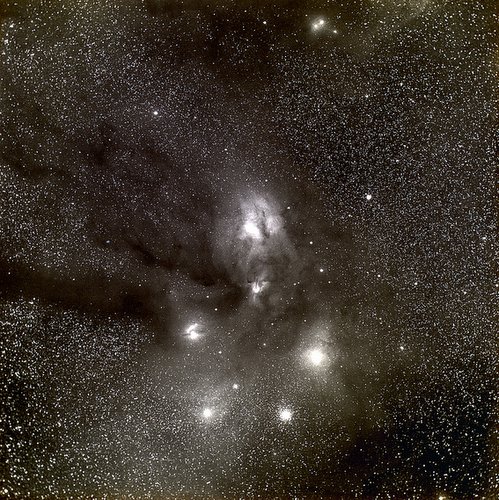The largest national association of astronomers is now the new home of a virtual observatory known as the WorldWide Telescope.

Imagine a future in which astronomy research comes to life. Rather than read a dry paper abstract, researchers will soon watch the paper’s author show and explain the observations. Scrolling through an article on, say, star formation, researchers can click on the images within and explore the actual regions where stars are born.
This future is now, and that’s why the American Astronomical Society, the largest national association of astronomers, has agreed to host the Worldwide Telescope, software that provides a window into the multiwavelength universe.
A Browser for the Universe
WorldWide Telescope is basically a virtual observatory, an online portal that theoretically allows access to any dataset ever taken. Anyone — researcher, amateur astronomer, or grade-school student — can open the application and see the galaxy as imaged by the Digitized Sky Survey, then overlay gamma-ray data from Planck or zoom in to a tour of Mars. (See more on the WorldWide Telescope’s uses in our April 2015 issue and accompanying online article, “How to Use the WorldWide Telescope.”)
The program began in 2008 under the auspices of Microsoft Research, which released a free desktop application for Windows systems. Soon a web application was developed, so the software could be used on any computer or device, not just a PC. And in 2015, the software went open-source to encourage a broader community to work on the code’s development.
Now the American Astronomical Society is taking over leadership of the project, a development that promises to revolutionize the way astronomers show their research to other professionals and to the public.
One of the first orders of business is to make research papers more interactive. Astronomers can now present their data in the form of video abstracts. In these mini-tours, the author takes a few minutes to guide the reader through his or her observations. They’re intended for professional audiences but are far more accessible to the average reader, too. Take a look at these two examples:
And the interactivity isn’t limited to the paper abstract. Figures within the paper will soon be interactive, too. When readers click on an image, they’ll then be able to zoom in or out, superimpose observations at other wavelengths, or even add their own data set. Here’s one example, Richard Barnard’s 100-year-old image of the Rho Ophiuchi star-forming complex. Click on the image to open it in WorldWide Telescope, then go explore!

Edward Emerson Barnard Photographic Atlas of Selected Regions of the Milky Way
To make all of this happen, a lot needs to be done behind the scenes: the WWT team is working to import more data sets, such as all-sky surveys into the program, and they’re also building tutorials and how-tos that will tell astronomers how to add their own observations, create their own video abstracts, and more.
But the benefits of WorldWide Telescope won’t be limited to professional astronomers — there’s lots of opportunity for outreach, both in schools and planetariums.
“Publishing is going to drive [development], and then once it gets going, schools will be the first to adopt it en masse,” predicts WWT team member Doug Roberts (Northwestern University).
In fact, there’s already an associated outreach program, the WorldWide Telescope Ambassadors. The program provides teachers with lesson plans (with more under development) that that they can use in front of the class or in lab settings, where students are encouraged to explore on their own. Graduate students, postdocs, and retired astronomers also travel out to classrooms as ambassadors, helping teach the phases of the Moon to a third-grade classroom or explaining deep surveys of the early universe to a university class.
After spending years moving the WorldWide Telescope from its original home with Microsoft to its open-source home at Github, and now to AAS leadership, Roberts is looking forward to fast-tracking the software’s potential. “Next year is going to be a big year for us.
 3
3









Comments
Anthony Barreiro
February 5, 2016 at 5:01 pm
Wow, this is very exciting. But I hope teachers and students won't spend all their time staring at computer screens and clicking on icons. Something irreplaceable would be lost if future generations never have a structured and mentored opportunity to get outside to observe and sketch the Moon, find the north star, learn to recognize some constellations, track planets moving through the zodiac, and look at some double stars, clusters, nebulae, and galaxies through a telescope. As Leslie Peltier said, "Were I to write out one prescription to help alleviate at least some of the self-made miseries of mankind, it would read like this: 'One gentle dose of starlight to be taken each clear night just before retiring.' "
You must be logged in to post a comment.
sina
February 7, 2016 at 3:52 pm
Agree 100%.
You must be logged in to post a comment.
Monica YoungPost Author
February 11, 2016 at 3:05 pm
Anthony, I also agree 100% . . . but at least at the elementary school level, teachers are somewhat limited in the activities they can pursue (or assign parents to pursue). Daytime events are far and few between - though I distinctly remember the day in third grade that we all headed outside to make pinhole cameras and see a partial eclipse of the Sun. But in the everyday cases such as teaching the history of Galileo's moon observations or the phases of the Moon, this can be incredibly useful tool for teachers.
You must be logged in to post a comment.
You must be logged in to post a comment.